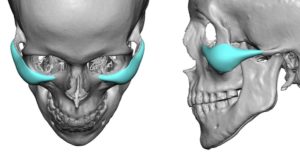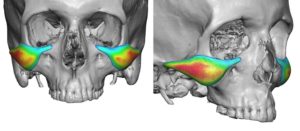Cheek implants come in a variety of styles and sizes to create slightly different midface augmentation effects. Many of the styles of cheek implants have surgeon names attached to them which does not help in understanding exactly what cheek effect they create. But fundamentally cheek implants effect either the malar or submalar regions.
The malar region of the cheek refers to augmentation of the zygomatic body proper. This is the convex outer surface of the larger portion of the cheekbone. On its outer central surface is the small foramen for the zygomaticoforamen neurovascular bundle and an elevated area for the origin of the zygomaticus muscle. This central bony area serves as the historic placement for an implant and thus comes the name of malar implants. The submalar region of the cheek refers to the lower edge of the zygomatic body as well as off the bone onto the masseteric fascia. It is really a combined bone and soft tissue augmentation implant.
Cheek implants today come in either malar, submalatr or combined malar-submalat styles. It is easy to see in any of their designs that their effects are over the main portion of the zygomatic bone which is effective for some but not all patients seeks cheek augmentation.
One cheek augmentation effect that some patients seek is the ‘high cheekbone look’. While this seemingly would be created by a malar cheek implant style, it does not usually create that exact desired effect. It is important to appreciate that creating a more prominent malar eminence must include the infraorbital processes in front of it and the zygomatic arch extensions in back of it. If not it will just look like a bump placed on the side of the cheeks. There is a limit as to how the zygoma can be augmented outward until it looks unnatural.


Dr. Barry Eppley
Indianapolis, Indiana



